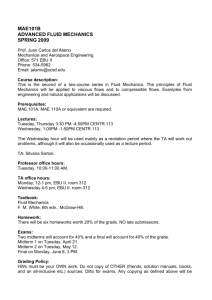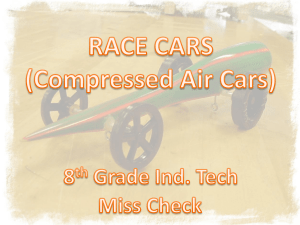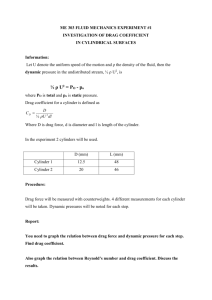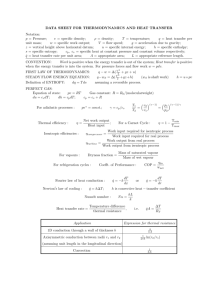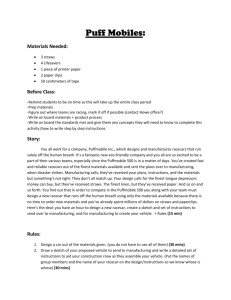Examples and Bernoulli Equation - Florida Institute of Technology
advertisement
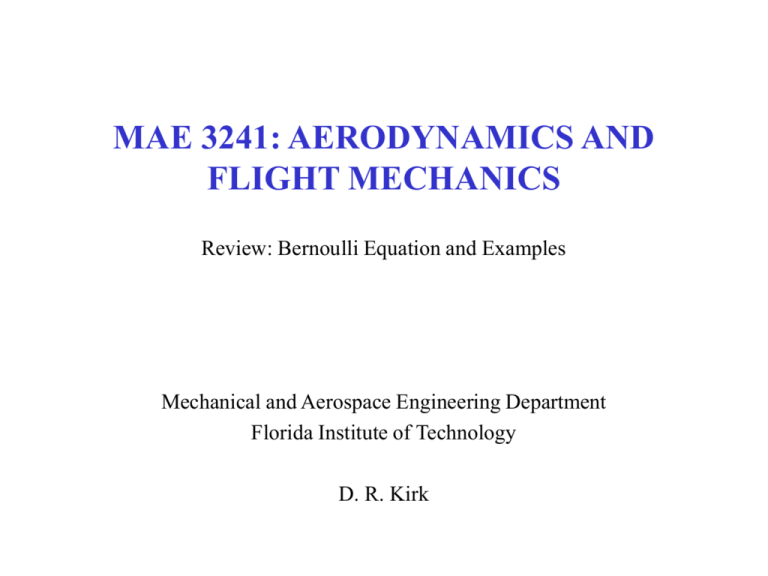
MAE 3241: AERODYNAMICS AND FLIGHT MECHANICS Review: Bernoulli Equation and Examples Mechanical and Aerospace Engineering Department Florida Institute of Technology D. R. Kirk LECTURE OUTLINE • Review of Euler’s Equation – Euler’s equation for incompressible flow → Bernoulli’s Equation • Review of Basic Aerodynamics – How does an airfoil or wing generate lift? – What are effects of viscosity? – Why does an airfoil stall? – Why are golf balls dimpled? WHAT DOES EULER’S EQUATION TELL US? dp VdV • Euler’s Equation (Differential Equation) – Relates changes in momentum to changes in force (momentum equation) – Relates a change in pressure (dp) to a chance in velocity (dV) • Assumptions we made: – Steady flow – Neglected friction (inviscid flow), body forces, and external forces • dp and dV are of opposite sign – IF dp increases dV decreases → flow slows down – IF dp decreases dV increases → flow speeds up • Valid for Incompressible and Compressible flows • Valid for Irrotational and Rotational flows INVISCID FLOW ALONG STREAMLINES Relate p1 and V1 at point 1 to p2 and V2 at point 2 Integrate Euler’s equation from point 1 to point 2 taking =constant dp VdV 0 p2 V2 p1 V1 dp VdV 0 V22 V12 0 p2 p1 2 2 BERNOULLI’S EQUATION 2 2 2 1 V V p2 p1 2 2 2 V p Constant along a streamline 2 • If flow is irrotational p+½V2 = constant everywhere • Remember: – Bernoulli’s equation holds only for inviscid (frictionless) and incompressible (=constant) flows – Relates properties between different points along a streamline or entire flow field if irrotational – For a compressible flow Euler’s equation must be used ( is a variable) – Both Euler’s and Bernoulli’s equations are expressions of F=ma expressed in a useful form for fluid flows and aerodynamics HOW DOES AN AIRFOIL GENERATE LIFT? • Lift is mainly due to imbalance of pressure distribution over the top and bottom surfaces of airfoil – If pressure is lower than pressure on bottom surface, lift is generated – Why is pressure lower on top surface? • We can understand answer from basic physics – Continuity – Newton’s 2nd law HOW DOES AN AIRFOIL GENERATE LIFT? 1. Flow velocity over the top of airfoil is faster than over bottom surface – Streamtube A senses upper portion of airfoil as an obstruction – Streamtube A is squashed to smaller cross-sectional area – Mass continuity AV=constant, velocity must increase Streamtube A is squashed most in nose region (ahead of maximum thickness) A B HOW DOES AN AIRFOIL GENERATE LIFT? 2. As velocity increases pressure decreases 1 p V 2 constant – Incompressible: Bernoulli’s Equation 2 – Compressible: Euler’s Equation dp VdV – Called Bernoulli Effect 3. With lower pressure over upper surface and higher pressure over bottom surface, airfoil feels a net force in upward direction → Lift Most of lift is produced in first 20-30% of wing (just downstream of leading edge) EVEN A FLAT PLATE WILL GENERATE LIFT • Curved surface of an airfoil is not necessary to produce lift – But it significantly helps to reduce drag A B EXAMPLE 2: WIND TUNNELS • A wind tunnel is a ground-based experimental facility used to produce air flow to study flight of airplanes, missiles, space vehicles, etc. • Many different types of wind tunnels – Subsonic, transonic, supersonic, hypersonic Excellent Wind Tunnel Site: http://vonkarman.stanford.edu/tsd/pbstuff/tunnel/ OPEN VS. CLOSED CIRCUIT WIND TUNNELS Open-Circuit Tunnel Closed-Circuit Tunnel Excellent Wind Tunnel Site: http://vonkarman.stanford.edu/tsd/pbstuff/tunnel/ EXAMPLE: LOW-SPEED, SUB-SONIC WIND TUNNEL • Subsonic wind tunnels generally operate at speeds < 300 MPH 1 Diffuser Contraction (Nozzle) Why build all of this? Fan Test Section 2 EXAMPLE: LOW-SPEED, SUB-SONIC WIND TUNNEL 2 1 • At speeds M < 0.3 ( or ~ 100 m/s) flow regarded as incompressible • Analyze using conservation of mass (continuity) and Bernoulii’s Equation 1V1 A1 2V2 A2 A1 V2 V1 A2 1 1 2 2 p1 V1 p2 V2 2 2 V 2 2 V2 2 p1 p2 V12 2 p1 p2 A 2 1 2 A1 EXAMPLE 3: MEASUREMENT OF AIRSPEED • How do we measure an airplanes speed in flight? • Pitot tubes are used on aircraft as speedometers (point measurement) STATIC VS. TOTAL PRESSURE • In aerodynamics, 2 types of pressure: Static and Total (Stagnation) • Static Pressure, p – Due to random motion of gas molecules – Pressure we would feel if moving along with the flow – Pressure in Bernoulli’s equation is static pressure • Total (Stagnation) Pressure, p0 or pt – Property associated with flow motion – Total pressure at a given point in flow is the pressure that would exist if flow were slowed down isentropically to zero velocity • p0 > p MEASUREMENT OF AIRSPEED: INCOMPRESSIBLE FLOW 1 2 p V1 p0 2 Static pressure V1 Dynamic pressure Total pressure 2 p 0 p Incompressible Flow SKETCH OF A PITOT TUBE (4.11) • Measures total pressure • Open at A, closed at B • Gas stagnated (not moving) anywhere in tube • Gas particle moving along streamline C will be isentropically brought to rest at point A, giving total pressure EXAMPLE: MEASUREMENT OF AIRSPEED (4.11) • Point A: Static Pressure, p – Surface is parallel to flow, so only random motion of gas is measured • Point B: Total Pressure, p0 – Aligned parallel to flow, so particles are isentropically decelerated to zero velocity • A combination of p0 and p allows us to measure V1 at a given point • Instrument is called a Pitotstatic probe p p0 MEASUREMENT OF AIRSPEED: INCOMPRESSIBLE FLOW 1 2 p V1 p0 2 Static pressure V1 Dynamic pressure Total pressure 2 p 0 p Incompressible Flow p 1 V12 p0 2 TRUE VS. EQUIVALENT AIRSPEED • What is value of ? • If is measured in actual air around the airplane • Measurement is difficult to do • Practically easier to use value at standard seal-level conditions, s • This gives an expression called the equivalent airspeed Vtrue Ve 2 p 0 p 2 p0 p s MEASUREMENT OF AIRSPEED: SUBSONIC COMRESSIBLE FLOW • If M > 0.3, flow is compressible (density changes are important) • Need to introduce energy equation and isentropic relations 1 2 c pT1 V1 c pT0 2 2 T0 V1 1 T1 2c pT1 T0 1 2 1 M1 T1 2 p0 1 2 1 M1 p1 2 0 1 2 1 M1 1 2 1 1 1 cp: specific heat at constant pressure M1=V1/a1 air=1.4 MEASUREMENT OF AIRSPEED: SUBSONIC COMRESSIBLE FLOW • So, how do we use these results to measure airspeed 1 p 2 0 M 12 1 1 p1 1 p 2 a 0 V12 1 1 p1 2 1 1 p p 2 a 1 0 V12 1 1 1 p1 2 1 2 Vcal 1 2a p0 p1 1 1 1 ps 2 s p0 and p1 give Flight Mach number Mach meter M1=V1/a1 Actual Flight Speed Actual Flight Speed using pressure difference What is T1 and a1? Again use sea-level conditions Ts, as, ps (a1=340.3 m/s) REAL EFFECTS: VISCOSITY (m) • To understand drag and actual airfoil/wing behavior we need an understanding of viscous flows (all real flows have friction) • Inviscid (frictionless) flow around a body will result in zero drag! – Called d’Alembert’s paradox (Must include friction in theory) We will derive this streamline pattern in class next week REAL EFFECTS: VISCOSITY (m) • Flow adheres to surface because of friction between gas and solid boundary – At surface flow velocity is zero, called ‘No-Slip Condition’ – Thin region of retarded flow in vicinity of surface, called a ‘Boundary Layer’ • At outer edge of B.L., V∞ • At solid boundary, V=0 “The presence of friction in the flow causes a shear stress at the surface of a body, which, in turn contributes to the aerodynamic drag of the body: skin friction drag” THE REYNOLDS NUMBER • One of most important dimensionless numbers in fluid mechanics/ aerodynamics • Reynolds number is ratio of two forces – Inertial Forces – Viscous Forces – c is length scale (chord) • Reynolds number tells you when viscous forces are important and when viscosity can be neglected V c Re m Outside B.L. flow Inviscid (high Re) Within B.L. flow highly viscous (low Re) LAMINAR VERSUS TURBULENT FLOW • Reynolds number also tells you about two types of viscous flows – Laminar: streamlines are smooth and regular and a fluid element moves smoothly along a streamline – Turbulent: streamlines break up and fluid elements move in a random, irregular, and chaotic fashion LAMINAR VERSUS TURBULENT FLOW All B.L.’s transition from laminar to turbulent Turbulent velocity profiles are ‘fuller’ cf,turb > cf,lam WHY DOES AN AIRFOIL STALL? • Key to understanding: Friction causes flow separation within boundary layer • Separation then creates another form of drag called pressure drag due to separation WHY DOES AN AIRFOIL STALL? • Key to understanding – Friction causes flow separation within boundary layer – Separation then creates another form of drag called pressure drag due to separation WHY DOES BOUNDARY LAYER SEPARATE? • Adverse pressure gradient interacting with velocity profile through B.L. • High speed flow near upper edge of B.L. has enough speed to keep moving through adverse pressure gradient • Lower speed fluid (which has been retarded by friction) is exposed to same adverse pressure gradient is stopped and direction of flow can be reversed • This reversal of flow direction causes flow to separate – Turbulent B.L. more resistance to flow separation than laminar B.L. because of fuller velocity profile – To help prevent flow separation we desire a turbulent B.L. WHY DOES AN AIRFOIL STALL? • Two major consequences of separated flow over airfoil – Dramatic loss of lift (stalling) • Separated flow causes higher pressure on upper surface of airfoil – Major increase in drag • Separation causes lower pressure on trailing edge • Unbalance of pressure force causes pressure drag due to separation SUMMARY OF VISCOUS EFFECTS ON DRAG • Friction has two effects: – Skin friction due to shear stress at wall – Pressure drag due to flow separation D D friction D pressure Total drag due to Drag due to = viscous effects skin friction Called Profile Drag + Less for laminar More for turbulent Drag due to separation More for laminar Less for turbulent So how do you design? Depends on case by case basis, no definitive answer! COMPARISON OF DRAG FORCES GOLF BALL AERODYNAMICS • Why are modern golf balls dimpled? • How important is skin friction? • How important is pressure drag (separation)? GOLF BALL AERODYNAMICS Large Wake of Separated Flow, High Pressure Drag Laminar B.L. Separation Point Reduced Size Wake of Separated Flow, Lower Pressure Drag Turbulent B.L. Separation Point GOLF BALL AERODYNAMICS DRAG Large Wake of Separated Flow, High Pressure Drag Laminar B.L. Separation Point Reduced Size Wake of Separated Flow, Lower Pressure Drag Turbulent B.L. Separation Point Drag due to viscous boundary layer skin friction GOLF BALL AERODYNAMICS DRAG Large Wake of Separated Flow, High Pressure Drag Laminar B.L. Separation Point Reduced Size Wake of Separated Flow, Lower Pressure Drag Turbulent B.L. Separation Point Pressure drag (due to viscous flow separation, wake) GOLF BALL AERODYNAMICS Large Wake of Separated Flow, High Pressure Drag Laminar B.L. Separation Point Reduced Size Wake of Separated Flow, Lower Pressure Drag Turbulent B.L. Separation Point DRAG Total Drag GOLF BALL AERODYNAMICS: SUMMARY • • • • Pressure drag dominates spheres and cylinders Dimples encourage formation of turbulent B.L. Turbulent B.L. less susceptible to separation Delayed separation → Less total drag COMPARISON OF DRAG FORCES d d Same total drag as airfoil



